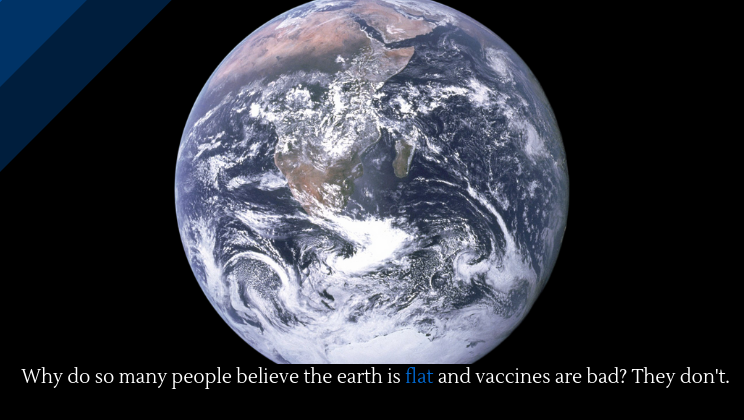Why do so many people believe the earth is flat and vaccines are bad? They don’t.
Posted by Josh Taylor / November 18, 2018
If you spend any time on the internet whatsoever, you’re likely to stumble across the flat earth theory or anti-vaxxers. The vast majority of the time, however, you’re not going to see anyone actually arguing in favor of the flat earth theory or against the efficacy of vaccines. Instead, you’re going to see a virtual mob, replete with virtual pitchforks, lambasting a tweet, or Facebook post. You don’t have to spend much energy looking around on Reddit, for example, to find examples mocking such ideas.
If you get wrapped up in the mob mentality, you could easily start to believe that there are tens of thousands––maybe even hundreds of thousands or millions!––of dumdums out there who deny the overwhelming evidence that the earth is round and that vaccines stop the spread of disease. You might even start to worry that measles is going to make a comeback because of people like this. The news coverage fans those flames Once again, Washington Post is guilty of using clickbait titles to drum up clicks. Note this hair-raising line:
In Camas County in southern Idaho, nearly 27 percent of the kindergarten population opted out of childhood vaccinations in the 2016-2017 school year, according to the study. Generally, the 10 counties with the highest exemption rates have fewer than 50,000 people and are in rural areas.
What WaPo didn’t make clear was just how tiny the population of Camas County is. As of 2010, there were 326 families. So if every single family had a kindergarten aged child, that would mean 88 kids weren’t vaccinated––that’s extremely unlikely, though. The census reveals that in 2010 there were only 63 kids under five years old, so only a small fraction of those kids would actually be kindergarten aged. Let’s assume there are 30 kids that fit the bill. That means there are about eight kids who are unvaccinated when the survey was conducted. Keeping in mind that this is a rural county, it’s also possible that vaccines simply had not happened yet, and when the kids advanced in grade school they would be required to get vaccinated. Twenty-seven percent seems a lot scarier than eight kids with some qualifications, though.
There’s similar chicanery that happens with the flat earth thing. Take a look at a snippet from this article:
Mocked and demeaned daily by family, friends and even strangers, hundreds of flat Earthers rejoiced with like-minded folks Thursday during the second annual Flat Earth International Conference at the Crown Plaza Airport Convention Center in Denver.
The two-day conference, put on by Canada-based Kryptoz Media, was packed with presentations and debates promoting and celebrating the theory that the Earth is flat.
The article leaves the number of participants at a vague “hundreds.” It followed that up with the phrase “packed with,” implying a large conference. You have to follow a link in the article to see real numbers:
[Organizer Robbie] Davidson said he has sold about 420 tickets to the Flat Earth International Conference so far and expects about 500 people to attend the two-day event on Nov. 15 and 16. The conference is organized by Davidson’s Canada-based company, Kryptoz Media, and tickets to attend the event range from $199 to $349. About 400 people attended the first conference held last year in Raleigh, N.C.
About 500 people are going to the conference, then, and the organizer estimates that 20% of those people are not flat earthers. So maybe 400 “true believers” will be there. Maybe 400 seems like a lot to you. But think about it this way: there are 252,000,000 adult Americans. That’s 0.00015873% of Americans who believe that the earth is flat and are going to that conference. Maybe a lot more can’t afford the $200 ticket and travel. Fine. Let’s say 1,000 Americans really believe the earth is flat. That’s .000396825% of Americans.
Anti-vaccination is actually a dangerous phenomenon, but we should never forget that it’s a small phenomenon. Flat earth theory is less dangerous and perhaps even smaller. If these aren’t significant, why the mob mentality in attacking them? That’s a question worth asking. In another article, I will posit some answers, but first you should leave your comments below.
More science.
Comments are off for this post.